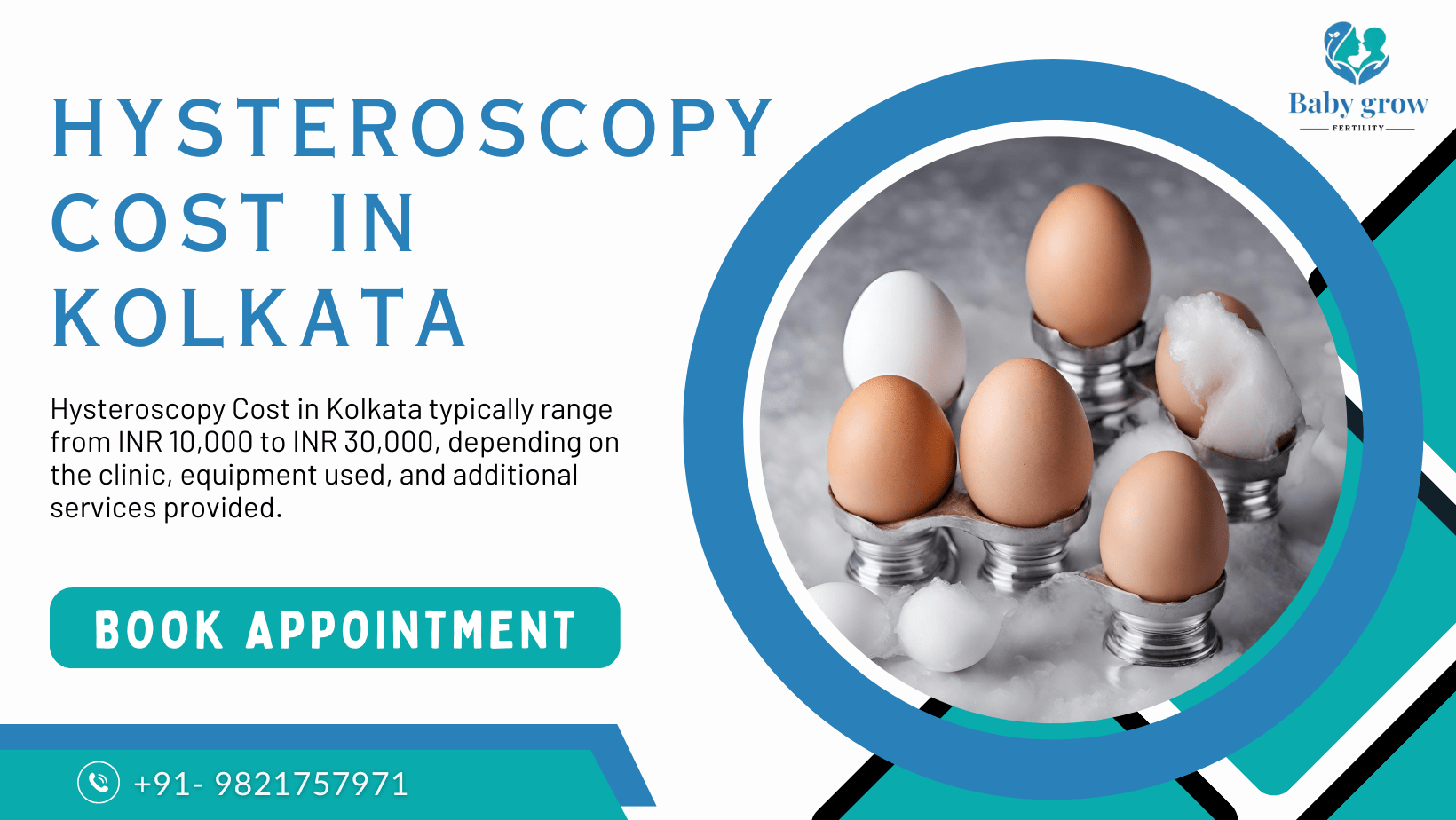Welcome to Baby Grow Fertility, your trusted destination for comprehensive fertility solutions in Kolkata. As part of our commitment to providing the best care, we understand the importance of transparency regarding procedures and costs. Today, we shed light on the hysteroscopy cost in Kolkata, a crucial diagnostic tool in fertility treatment.
Hysteroscopy is a minimally invasive procedure used to examine the inside of the uterus, aiding in the diagnosis and treatment of various reproductive issues. In Kolkata, the cost of hysteroscopy can vary depending on several factors, including the clinic’s reputation, the expertise of the medical team, and the complexity of the procedure required for individual cases.
At Baby Grow Fertility, we prioritize affordability without compromising on quality. Our dedicated team ensures that patients receive personalized care tailored to their needs while offering competitive hysteroscopy costs in kolkata. We believe in empowering individuals with knowledge and support throughout their fertility journey, and understanding the expenses involved is an integral part of that journey. Contact us today to learn more about hysteroscopy and how we can assist you on your path to parenthood.
What is Hysteroscopy?
Hysteroscopy is a minimally invasive surgical procedure used by gynecologists to examine the inside of the uterus. During a hysteroscopy, a thin, lighted tube called a hysteroscope is inserted through the vagina and cervix into the uterus, allowing the doctor to visualize the uterine cavity and diagnose any abnormalities or conditions affecting the uterus, such as fibroids, polyps, or adhesions. It can be performed for diagnostic purposes to investigate abnormal uterine bleeding, infertility issues, or recurrent miscarriages, as well as for therapeutic interventions such as removing polyps or fibroids.
Importance of Hysteroscopy in Gynecology
Hysteroscopy plays a crucial role in the field of gynecology as it offers a direct and minimally invasive method for evaluating and treating various uterine conditions. Unlike traditional diagnostic methods like dilation and curettage (D&C), which can be more invasive and less accurate, hysteroscopy provides a clear view of the uterine cavity, allowing for accurate diagnosis and targeted treatment. Its importance extends to both diagnostic and operative procedures, making it a valuable tool for managing gynecological issues ranging from abnormal bleeding to infertility.
Evolution of Hysteroscopy Techniques
Over the years, hysteroscopy techniques have evolved significantly, driven by advancements in medical technology and surgical instrumentation. Initially introduced as a diagnostic tool in the early 20th century, hysteroscopy has undergone notable improvements in terms of equipment design, visualization capabilities, and surgical techniques. The introduction of miniaturized hysteroscopes, high-definition cameras, and advanced energy sources has enhanced the safety and efficacy of hysteroscopic procedures, allowing for more precise diagnosis and minimally invasive treatment options. These advancements have revolutionized the field of gynecology, making hysteroscopy a cornerstone in the management of uterine disorders and reproductive health.
Understanding Hysteroscopy Procedure
A. Preparing for a Hysteroscopy
Before undergoing a hysteroscopy, patients will typically receive instructions from their healthcare provider regarding preparations for the procedure. This may include fasting for a certain period before the procedure, informing the doctor about any medications being taken, and discussing any allergies or health conditions that may impact the procedure. Patients may also be advised to arrange for transportation to and from the hospital or clinic, as well as to plan for a period of rest following the procedure.
B. Step-by-step Procedure
- Anesthesia Administration: The hysteroscopy procedure may be performed under local anesthesia, regional anesthesia, or general anesthesia, depending on the patient’s medical history, preferences, and the nature of the procedure. Local anesthesia involves numbing the cervix and uterine lining, while regional anesthesia numbs a larger area of the body, and general anesthesia renders the patient unconscious throughout the procedure. The choice of anesthesia will be discussed and decided upon between the patient and their healthcare provider prior to the procedure.
- Insertion of Hysteroscope: Once the patient is properly anesthetized, the hysteroscope—a thin, flexible tube with a light and camera at its tip—is gently inserted through the vagina and cervix into the uterine cavity. The hysteroscope allows the healthcare provider to visualize the inside of the uterus and identify any abnormalities or issues.
- Examination of Uterine Cavity: As the hysteroscope is guided through the uterine cavity, the healthcare provider carefully examines the walls of the uterus, looking for signs of abnormalities such as polyps, fibroids, adhesions, or other structural issues. The camera attached to the hysteroscope provides real-time images, allowing for a thorough evaluation of the uterine lining.
- Possible Interventions: Depending on the findings during the examination, the healthcare provider may perform certain interventions or procedures during the hysteroscopy. This could include taking tissue samples for biopsy, removing polyps or fibroids, correcting uterine abnormalities, or addressing issues such as excessive menstrual bleeding. Any interventions will be discussed with the patient prior to the procedure, and informed consent will be obtained.
Recovery Process after Hysteroscopy
Following the hysteroscopy procedure, patients are typically monitored in a recovery area for a short period to ensure there are no immediate complications. Depending on the type of anesthesia used, patients may experience varying levels of drowsiness or discomfort immediately after the procedure. Pain medication may be prescribed to manage any discomfort, and patients are usually advised to rest at home for the remainder of the day. Most patients are able to resume normal activities within a day or two following the procedure, although strenuous activities and sexual intercourse may be advised against for a short period to allow for proper healing. Any specific post-procedure instructions will be provided by the healthcare provider, and patients are encouraged to follow these instructions closely to ensure a smooth recovery process.
Average Cost of Hysteroscopy in Kolkata
The average Cost of hysteroscopy in Kolkata can vary depending on factors such as the clinic, the complexity of the procedure, and any additional services required. Typically, hysteroscopy costs range from INR 8,000 to INR 25,000 in Kolkata. However, it’s important to consult with a healthcare provider to receive an accurate estimate tailored to your specific needs and circumstances. Factors such as anesthesia, pre-operative testing, and post-operative care may also influence the final cost. Seeking transparency and discussing all potential expenses beforehand ensures a smooth and well-informed experience for individuals undergoing hysteroscopy procedures in Kolkata.
Conclusion
In conclusion, understanding the average Cost of hysteroscopy in Kolkata is essential for individuals seeking this diagnostic or therapeutic procedure. While prices may vary depending on factors like the clinic’s reputation, the doctor’s expertise, and additional services provided, having a ballpark figure can help individuals make informed decisions about their healthcare. By researching and comparing costs, patients can ensure they receive quality care at a fair price. Moreover, discussing financial matters and potential payment options with healthcare providers can help alleviate any concerns about affordability. Ultimately, prioritizing both quality and affordability ensures a smoother and more accessible healthcare experience for all.
Frequently Asked Questions (FAQs)
A. What is the typical duration of a hysteroscopy procedure?
Ans: The typical duration of a hysteroscopy procedure is usually between 15 minutes to an hour, depending on the complexity of the case and any interventions required.
B. Can hysteroscopy be performed under local anesthesia?
Ans: Yes, hysteroscopy can be performed under local anesthesia, regional anesthesia, or general anesthesia, depending on the patient’s preferences and the nature of the procedure.
C. Is hysteroscopy painful?
Ans: Hysteroscopy is usually not painful, as anesthesia is administered to numb the cervix and uterine lining before the procedure. Some patients may experience mild discomfort or cramping during or after the procedure, but this can typically be managed with over-the-counter pain medication.
D. How long does it take to recover from a hysteroscopy?
Ans: Recovery from a hysteroscopy is relatively quick, with most patients able to resume normal activities within a day or two. However, it’s advisable to avoid strenuous activities and sexual intercourse for a short period to allow for proper healing.
E. Can hysteroscopy diagnose fertility issues?
Ans: Yes, hysteroscopy can help diagnose certain fertility issues such as uterine abnormalities, polyps, fibroids, or adhesions that may interfere with conception or pregnancy.
F. Are there any alternatives to hysteroscopy for diagnosing uterine conditions?
Ans: Yes, there are alternatives to hysteroscopy for diagnosing uterine conditions, including ultrasound, MRI, and saline infusion sonohysterography (SIS). However, hysteroscopy is considered the gold standard for direct visualization and diagnosis of intrauterine abnormalities.
G. Can hysteroscopy be performed during pregnancy?
Ans: In certain cases, hysteroscopy can be performed during pregnancy, particularly for diagnostic purposes or to address specific uterine issues that may affect pregnancy outcomes. However, the procedure is generally avoided during the first trimester unless absolutely necessary.
H. How often should hysteroscopy be performed for routine gynecological check-ups?
Ans: The frequency of hysteroscopy for routine gynecological check-ups varies depending on individual health factors and risk factors. It’s best to consult with a healthcare provider to determine the appropriate frequency based on specific medical history and needs.




